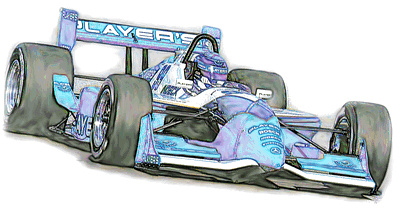CART: Mercedes; Learning Lessons When Bad Things Happen to Good Engines
21 April 1998
MONTVALE, N.J. -- Just over a year ago the all-new Mercedes-Benz IC108E Champ Car engine was nothing more than an idea. Still, in three CART FedEx Championship Series races to date, it has performed more like a tried-and-true veteran than the emerging rookie that it is. As Mercedes-Benz Motorsport Teams head for the Bosch Spark Plug Grand Prix at Nazareth, Pa., April 24-26, they can credit much of that performance record to the distinct development process at Ilmor Engineering -- the racing engine design and manufacturing arm of Mercedes.

Greg Moore, One of many using Mercedes engines
Pushing the Performance Envelope
Provided you start with a fundamentally sound design, most engines can be reliable. The challenge -- particularly in the ultra-competitive environment of the FedEx Championship Series -- is to create a powerplant that is both reliable and powerful.
"Very quickly after starting up a new engine on the dyno, you find an rpm level at which it runs reliably," explained Ray. "It's when you start to push the performance envelope that you begin to find weaknesses, so you fix problems a little bit at a time, testing, failing, re-designing and testing again. It's designing by a process of evolution."
Forensic Engine Design
Learning lessons a failed engine can teach is tricky business. With each piston cycling up and down more than 240 times per second, even a small failure in the tight confines of a modern racing engine can result in shrapnel. Components may literally be pounded into bits before the driver can shut down the engine. In such a case, engineers must collect and sift through the pieces, looking for evidence to reveal the origin of the problem.
"You have to keep an open mind and try not to make instant judgments," said Alan Peck, Ilmor's quality manager, a 33-year racing veteran and the man ultimately responsible for each post-mortem. "Sometimes the clues are all there, and sometimes they've been destroyed before shut-down. The trick is to establish the progression of the failure and trace it back to its origin."
If the failure occurs at the track, the engine and its data record get an initial inspection on site in hope of learning the cause immediately and assessing the chance of similar problems occurring in other engines that weekend. Next, the engine is sent back to the assembly/rebuild facility where it is taken apart, and each piece is carefully washed and inspected. Finally, the broken parts are sent back to Ilmor's headquarters in Brixworth, England, for Peck's detailed analysis. That process can include microscopic inspection and metallurgical investigations.
Ray sums up the process by saying, "People might think racing engine developers invent new bits and just hand them to the teams. In reality, its more like a closed-loop process. We engineer and develop, rig-test, dyno-test, track-test, all the while evaluating the data. Along the way, engine failures are common, particularly in the early stages. The idea, obviously, is to be sure that by the time we race, the engines are as reliable as possible."
Returning to the Scene
Nazareth Speedway holds fond memories for both Mercedes-Benz and Ilmor Engineering. The 1997 Bosch Spark Plug Grand Prix marked the beginning of a six-race winning streak for last seasons championship-winning Mercedes-Benz IC108D engine. The one-mile oval was also the site of Ilmors 100th win, which was scored by Emerson Fittipaldi in 1995. Emerson Fittipaldi brought home win number 100 for Ilmor in the Nazareth round of the championship in 1995.
Mercedes-Benz Employee Motorsport Day
On Sunday, April 26, Mercedes-Benz of North America will entertain some 1,200 of its employees and their families. They will make the trip from company headquarters in Montvale, N.J. to the one-mile oval in Nazareth, Pa., to watch the Bosch Spark Plug Grand Prix first hand.
Editors Note: The images displayed in this article (plus many more) can be viewed in the Visions of Speed Art Gallery and the Racing Image Galleries.


